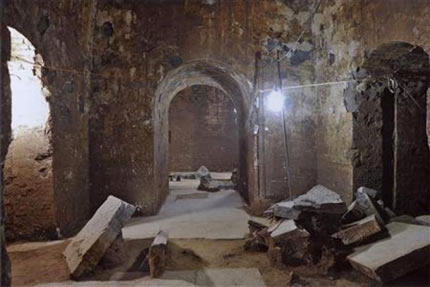Controversy around Cao Cao's tomb
Some Chinese scholars argue that there is not enough evidence to confirm the tomb in Ha Nam is the burial place of Wei King Cao Cao.

Inside Cao Cao's tomb. Photo: Reuters.
The Global Times quoted Professor Yuan Jixi, a researcher of ancient literature at the People's University, who said the tomb was heavily excavated before archaeologists began excavating it. Therefore, the artifacts found may be fake and not enough to convince this is Cao Cao's grave. Professor added that the tomb's location is not the same as the historical records of the time.
Professor Gao Menghe of Fudan University also shares this view. He said it was still too early to say that it was a grave of the great Han Dynasty military. He called for samples of DNA from the skull found and compared to Cao Cao's descendants.
However, Pan Weibin, the head of the group, made a grave, rejecting the suspicions. He asserts that the two professors' opinions are not professional because they are not archaeologists.
Chinese archaeologists began excavating a grave believed to be of King Wei Cao Cao from the end of last year. The grave area is 740 m 2 and divided into two compartments. Scientists believe that Cao Cao was buried with his wife and a maid. This discovery has just been published.
Cao Cao (155-220) was the last minister of the Eastern Han Dynasty before establishing the Wei Wei government during the Three Kingdoms period in China. He died in Luoyang, the capital of the Eastern Han Dynasty. After depicting the throne of King Han Hien De, Cao Cao's son, Cao Phi, venerated his father Thai To Vu Hoang De. Therefore his tomb is considered a royal tomb.
- Science has proven: The more the pair quarrels, the happier they are?
- Scary discovery about 1,400-year-old 'tomb of ghosts'
- The tombs are the most mysterious in the world
- Controversy surrounding the discovery of ancient tombs of the great saint Ton Ngo Khong?
- Controversy over the grave of the eminent Queen of Egypt
- The secret of an ancient tomb is 800 years old in China
- Discovered a 4,400-year-old tomb in Egypt
- Found the tomb of Jesus?
- Discover the oldest tomb of the Maya period
- The secret still covers the tomb of Qin Shihuang
- 6 reasons to prove the tomb is Cao Cao's
- China excavated the tomb of Qin Shihuang's grandmother
 Discovered an ancient centipede fossil 99 million years old
Discovered an ancient centipede fossil 99 million years old Discovered bat-like dinosaurs in China
Discovered bat-like dinosaurs in China Discovered a 200-year-old bronze cannon of the coast
Discovered a 200-year-old bronze cannon of the coast Discover 305 million-year-old spider fossils
Discover 305 million-year-old spider fossils